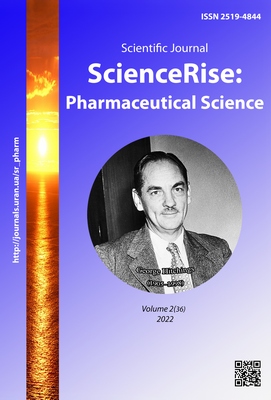Comparative analysis of drug consumption for the treatment of epilepsy in Ukraine, Kazakhstan and Belarus
DOI:
https://doi.org/10.15587/2519-4852.2022.255840Keywords:
pharmaceutical market, consumption volumes, epilepsy, , antiepileptic drugs, growth / loss rates, WHO Basic List of Essential MedicinesAbstract
The aim to conduct a comparative analysis of the population's consumption of antiepileptic drugs in the retail pharmaceutical markets of developing countries, including Ukraine, Kazakhstan and Belarus in the period 2016-2020.
Materials and methods. The objects of the research were the data of marketing agencies that monitor the domestic pharmaceutical market in the countries under study. In particular, the range of AED in Ukraine was determined using the market research system «Pharmstandard» of the company «Morion». Analytical-comparative, systematic, graphical, logical, mathematical-statistical research methods were used.
Results. The results of the study show that the market of antiepileptic drugs in Ukraine, Kazakhstan and Belarus mainly depends on foreign manufacturers, in particular by 60 %, 92 % and 46 % respectively in 2020, and does not meet the needs of the population in accordance with WHO recommendations. It is established that in the market of Ukraine, Kazakhstan during 2016-2019 there is a general trend of increasing retail sales of antiepileptic drugs, which are not included in the WHO Basic List of Essential Medicines, both in natural and in monetary terms. The results of the analysis of retail sales of drugs in the Belarusian market in quantitative and monetary terms indicate an increase in sales of drugs for the treatment of epilepsy, which are included in the WHO Basic List of Essential Medicines.
Conclusions. The presence in Ukraine of a difficult situation with the consumption of antiepileptic drugs in comparison with other countries of the reference group indicates the need to implement comprehensive programs to combat the spread of epilepsy and the introduction of models for the rational use of limited health resources
References
- Panfilova, H., Olkhovska, A., Boboshko, L., Iurchenko, G., Bandura, M., Dominik, Z. (2021). Results of a comparative analysis of the dynamics of healthcare expenditure from the GDP of countries, cash payments from families and state expenditures on healthcare in Ukraine, Poland and in the WHO European countries. ScienceRise: Pharmaceutical Science, 1 (29), 17–24. doi: http://doi.org/10.15587/2519-4852.2021.225443
- Kurylenko, Yu., Podgaina, M., Popova, I., Teterich, N. (2221). Investigating approaches to treating patients with atrial fibrillation based on the defined daily dose. PharmacologyOnline, 3, 60–66.
- Jamison, D. T., Summers, L. H., Alleyne, G., Arrow, K. J., Berkley, S., Binagwaho, A. et. al. (2013). Global health 2035: a world converging within a generation. The Lancet, 382 (9908), 1898–1955. doi: http://doi.org/10.1016/s0140-6736(13)62105-4
- Kotvitska, A. A., Cherkashyna, A. V., Volkova, A. V., Kubarieva, I. V. (2018). Analysis of the current state and the dynamics of lipid-lowering drugs in the pharmaceutical market of Ukraine. Asian Journal of Pharmaceutical and Clinical Research, 11 (6), 358–362. doi: http://doi.org/10.22159/ajpcr.2018.v11i6.22702
- Epilepsy: a public health imperative 2019 (2019). World Health Organization. Available at: https://www.ilae.org/files/dmfile/19053_Epilepsy_A-public-health-imperative-For-Web.pdf
- Shcho treba znaty pro epilepsiiu (2019). Tsentr hromadskoho zdorov’ia MOZ Ukrainy. Available at: https://phc.org.ua/news/scho-treba-znati-pro-epilepsiyu
- Beghi, E. (2019). The Epidemiology of Epilepsy. Neuroepidemiology, 54 (2), 185–191. doi: http://doi.org/10.1159/000503831
- Beghi, E. (2016). Addressing the burden of epilepsy: Many unmet needs. Pharmacological Research, 107, 79–84. doi: http://doi.org/10.1016/j.phrs.2016.03.003
- Interstate Statistical Committee of the CIS countries. Available at: http://www.cisstat.com
- Doslidzhennia farmatsevtychnoho rynku Ukrainy analitychnoi kompanii «Farmstandart» kompanii «Morion». Available at: http://www.pharmstandart.com.ua
- Klasyfikatsiia protyepileptychnykh zasobiv. Available at: https://pidru4niki.com/68255/meditsina/protisudomni_likarski_zasobi
- Wirtz, V. J., Hogerzeil, H. V., Gray, A. L., Bigdeli, M., de Joncheere, C. P., Ewen, M. A. et. al. (2017). Essential medicines for universal health coverage. The Lancet, 389 (10067), 403–476. doi: http://doi.org/10.1016/s0140-6736(16)31599-9
- Volkova, A. V., Korzh, Y. V., Olieinikova, N. V., Tereshchenko, L. V., Zaitseva, Y. L. (2019). The study of the epileptic population morbidity rate in Ukraine at the state and regional level. Social Pharmacy in Health Care, 5 (4), 14–22. doi: http://doi.org/10.24959/sphhcj.19.173
- Research of epilepsy in Ukraine. Available at: https://moz.gov.ua/article/statistic/centr-medichnoi-statistiki-moz-ukraini
- Unified clinical protocol of primary, emergency, secondary (specialized) and tertiary (highly specialized) medical care (2013). Available at: https://www.vnmu.edu.ua/downloads/pdf/OSKI_prot-epilep(dorosli)_med-ps-2020.pdf
- NICE CG 137 – The Epilepsies: The diagnosis and management (Epilepsy: diagnosis and treatment of epilepsy in adults and children in primary and secondary care) (2012). Available at: https://www.nice.org.uk/guidance/cg137
- Glauser, T., Ben-Menachem, E., Bourgeois, B., Cnaan, A., Guerreiro, C. et. al. (2013). Updated ILAE evidence review of antiepileptic drug efficacy and effectiveness as initial monotherapy for epileptic seizures and syndromes. Epilepsia, 54 (3), 551–563. doi: http://doi.org/10.1111/epi.12074
- Kwan, P., Arzimanoglou, A., Berg, A. T., Brodie, M. J., Allen Hauser, W., Mathern, G. et. al. (2009). Definition of drug resistant epilepsy: Consensus proposal by the ad hoc Task Force of the ILAE Commission on Therapeutic Strategies. Epilepsia, 51 (6), 1069–1077. doi: http://doi.org/10.1111/j.1528-1167.2009.02397.x
- WHO Model List of Essential Medicines (2019). Available at: https://apps.who.int/iris/bitstream/handle/10665/325771/WHO-MVP-EMP-IAU-2019.06-eng.pdf
- Cappello, B., Moja, L., Figueras, A., Magrini, N. (2020). The “Square Box”: Therapeutic Equivalence as a Foundation of the WHO Model List of Essential Medicines. Frontiers in Pharmacology, 11. doi: http://doi.org/10.3389/fphar.2020.578000
- Begley, C. E., Durgin, T. L. (2015). The direct cost of epilepsy in the United States: A systematic review of estimates. Epilepsia, 56 (9), 1376–1387. doi: http://doi.org/10.1111/epi.13084
- Allers, K., Essue, B. M., Hackett, M. L., Muhunthan, J., Anderson, C. S., Pickles, K. et. al. (2015). The economic impact of epilepsy: a systematic review. BMC Neurology, 15 (1). doi: http://doi.org/10.1186/s12883-015-0494-y
Downloads
Published
How to Cite
Issue
Section
License
Copyright (c) 2022 Iuliia Korzh, Natalia Olieinikova, Marharyta Beketova, Inna Kubarieva, Evgenia Korobova, Olga Afanasenko

This work is licensed under a Creative Commons Attribution 4.0 International License.
Our journal abides by the Creative Commons CC BY copyright rights and permissions for open access journals.








